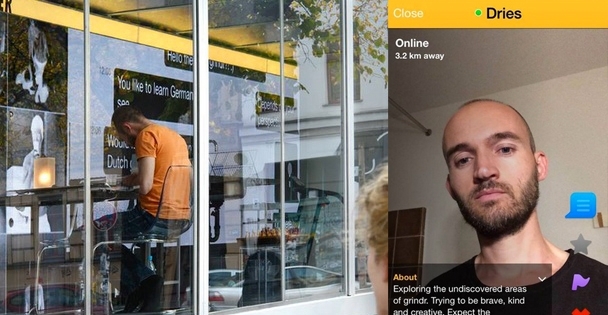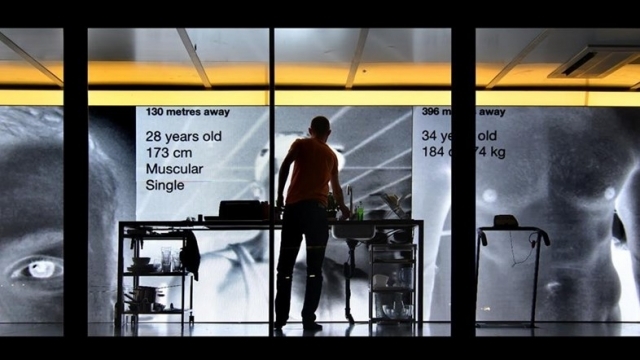[Opinion] Wanna Play? Dries Verhoeven, Berlin [해외문화]
Love in the Time of Grindr
글 입력 2015.07.06 10:24
-
 ⊂ Wanna-play.jpgWanna Play?, Source : Google image
⊂ Wanna-play.jpgWanna Play?, Source : Google image
Wanna Play? (Love in the Time of Grindr)by Dries Verhoeven
Dutch artist Dries Verhoeven has been attempting to hookup with his fellow Berliners in the name of art, displaying their Grindr chats in a public square and luring them to platonic hookups , leading the social app to accuse Verhoeven of “entrapment.”For his project, “Wanna Play,” Verhoeven engaged men on Grindr to satisfy one another’s nonsexual needs. “I will play chess with them,” he explained on his website, “have breakfast, make pancakes, trim nails, we’ll shave one another or read to one another from our favourite books.” Verhoeven has set up a large container with glass walls in the center of a busy square where users’ messages are displayed and the artist plays hosts to his nonsexual partners.“I see the glass container as a materialized chat box,” Verhoeven continued. “The screen of my smartphone will be visible on a large LED panel. To avoid immediately bringing on the wrath of a whole community, the men’s faces will be unrecognizable, but the conversations can be followed word for word.”Review of‘Wanna play?’
Social networks have become a central feature of everyday life. Most young people are members of at least one online social network, and they naturally provide a great deal of personal information as a condition for participation in the rich online social lives these networks afford.Social network information is essentially public in nature, and thus does not generate a subjective expectation of privacy necessary to support civil rights-based privacy protection. But the problem is that this information is being used by criminal, reporter.In Berlin, Dries Verhoven’s ‘Wanna play?’ had been scrapped just five days into its run. He was heavily criticized for publicly broadacasting private message with other Grindr users, including photographs and profile names, as a comment on the dating app. ( Grindr is a dating app for someone who is gay ) With the rise of social networking and photo-sharing, artists are scanning everything for materialand it’s resulting in some uncomfortable forays into digital privacy.I consider that online social spaces are indeed locus of public display rather than private revelation. Online profiles are structured with the view that ‘everyone’ can see them, even if the explicitly intended audience is more limited. These social norms are inconsistent with the claim that social media are private spaces. Instead, it appears that participants view and treat online social networks as public venues.Is profile on Grindr ‘private’ or ‘public’?Information posted to Grindr is ‘public’ in nature. It is entirely possible, however, that participants could nonetheless treat this information as ‘private’ in the sense that social norms preclude sharing this information outside the original distribution list, or suggest in other ways that the information is ‘private’ rather than ‘public’When Verhoven shared Grindr profile and conversation between him and user in public space, he losts control. He uses their private lives as fuel for art world rhetoric. As people in Berlin react angrily to such invasion of privacy, the performance was shut down.
 ⊂ Image of 'Wanna Play? , Source : Google imageIf online social spaces are private spaces, the social norms should censure sharing of information beyond the original audience, and participants should feel free to post information they consider to be sensitive in nature. By contrast, if these are public spaces, ‘re-sharing’ of posted information should be supported and accepted, and participants should take care to share only that information they intend to be widely shared.Boyd characterizes online social spaces as ‘networked publics’, consisting of digitally interconnected audiences with indistinct boundaries.The social practices and expectations described by Grindr user are consistent with this concept, in that their online profiles are produced for and most participate as members of exactly such large and loosely linked social groups. In particular, online profiles are structured with the view that ‘everyone’ (at least the members of a broad and socially coherent group with what might be described as ‘blurry’ or ‘leaky’ boundaries) could see them, even if the explicitly intended audience is more limited, and users of Grindr generally treat information posted by and about others in the same vein, treating profile as tantamount to public disclosure that allows discussion both within and beyond the online social connections to whom it is explicitly disclosed. These social norms are inconsistent with the claim that Grindr is a private space; instead, it appears that users view and treat online social networks as public venues.
⊂ Image of 'Wanna Play? , Source : Google imageIf online social spaces are private spaces, the social norms should censure sharing of information beyond the original audience, and participants should feel free to post information they consider to be sensitive in nature. By contrast, if these are public spaces, ‘re-sharing’ of posted information should be supported and accepted, and participants should take care to share only that information they intend to be widely shared.Boyd characterizes online social spaces as ‘networked publics’, consisting of digitally interconnected audiences with indistinct boundaries.The social practices and expectations described by Grindr user are consistent with this concept, in that their online profiles are produced for and most participate as members of exactly such large and loosely linked social groups. In particular, online profiles are structured with the view that ‘everyone’ (at least the members of a broad and socially coherent group with what might be described as ‘blurry’ or ‘leaky’ boundaries) could see them, even if the explicitly intended audience is more limited, and users of Grindr generally treat information posted by and about others in the same vein, treating profile as tantamount to public disclosure that allows discussion both within and beyond the online social connections to whom it is explicitly disclosed. These social norms are inconsistent with the claim that Grindr is a private space; instead, it appears that users view and treat online social networks as public venues.
ReferenceTverdek, E. (2008). What makes information ‘public’? Public Affairs Quarterly, 22(1), 63쭯77.Petronio, S. (2002). Boundaries of privacy: Dialectics of disclosure. Albany: State University of New York.boyd, d. (2007). Why youth social network sites: The role of networked publics in teenage social life. In D. Buckingham (Ed.), Youth, identity, and digital media (pp. 119쭯142). Cambridge, MA: MIT Press.Les Fabian Brathwaite. NewNowNext. Post, 7 Oct. 2014. Web. 3 Jul. 2015.[YEEHYUN KIM 에디터]<저작권자 ⓒ아트인사이트 & www.artinsight.co.kr 무단전재-재배포금지.>

